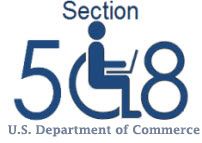Older workers are an important segment of the federal workforce and often bring valuable experience and institutional knowledge to their role. The average age of Federal employees is increasing each year as baby boomers age. Many of those individuals will continue to work after age 65.
The Americans with Disabilities Act of 1990 requires employers to accommodate people with disabilities. A person has a disability if “he/she has a physical or mental impairment that substantially limits one or more major life activities” (EEOC). In some cases, their disability may be related to aging, such as hearing loss. In others, the employee may have had a lifelong disability, which changes or is exacerbated by aging.
Age-related limitations can involve a wide range of conditions, impacting vision, cognition, communication, hearing and dexterity. The same assistive technology accommodations CAP provides for employees with life-long disabilities can be provided to employees with newly acquired age-related disabilities.
As age-related disabilities may come on gradually and change over time, employees may not be aware that there are assistive technology accommodations available, some even within their existing computer environment. Helping aging workers understand optimal ergonomics and built in technology options is a first step. Education about the range of technology options available for employees and how they can help workers be successful is also critical.
Many accommodations for aging workers don’t include technology at all, like a flexible work schedule, for example. The Job Accommodation Network offers information about a wide range of accommodations for aging workers, as well as some example scenarios of suggested accommodations.
To see this article and more from Computer/Electronic Accomodations Program (CAP), please visit: http://www.cap.mil/Documents/CAPtions_Summer_2013acc.pdf
Accomodation Ideas for Senior Aged Empoyees
Activities of Daily Living |
Fatigue/Weakness: |
|---|---|
Allow use of a personal attendant at work |
Reduce or eliminate physical exertion and workplace stress |
Allow use of a service animal at work |
Schedule periodic rest breaks away from the workstation |
Make sure the facility is accessible |
Allow a flexible work schedule and flexible use of leave time |
Move workstation closer to the restroom |
Provide parking close to the work-site and an accessible entrance |
Allow longer breaks or more frequent, shorter breaks |
Install automatic door openers |
Refer to appropriate community services |
Provide an accessible route of travel to other work areas used by the employee |
Provide access to a refrigerator |
Move workstation close to other work areas, office equipment, and break rooms |
| Allow a self-paced workload |
| Gross Motor Impairment: | Hearing Limitations: |
|---|---|
Modify the work-site to make it accessible |
Provide visual or tactile alerting device |
Provide parking close to the work-site |
Implement a buddy system |
Provide an accessible entrance |
Provide an assistive listening device (ALD) |
Install automatic door openers |
Provide communication access real-time translation (CART) |
Provide an accessible restroom and break room |
Provide computer-assisted note taking |
Provide an accessible route of travel to other work areas used by the employee |
Address environmental factors, i.e., background noise, lighting, and positioning |
Modify the workstation to make it accessible |
Provide an interpreter |
Adjust desk height if wheelchair or scooter is used |
Use Web-based meeting software or video conferencing |
Make sure materials and equipment are within reach range |
Provide standard note taking or other text information |
Move workstation close to other work areas, office equipment, and break rooms |
Allow tape recording of meetings |
Provide lifting devices and carts |
Provide speech recognition software / Close Captioning |
Maintaining Concentration: |
Muscle Pain and Stiffness: |
|---|---|
Reduce distractions in the work area |
Implement ergonomic workstation design, i.e., ergonomic chair and adjustable |
Provide space enclosures or a private office |
Use a workstation to alternate between sitting and standing |
Make sure materials and equipment are within reach range |
Reduce repetitive tasks or interrupt the tasks with other duties |
Allow the employee to play soothing music using a cassette player and headset |
Provide carts and lifting aids |
Increase natural lighting or provide full spectrum lighting |
Modify work-site temperature and/or dress code |
Divide large assignments into smaller tasks and steps |
Use fan/air-conditioner or heater at the workstation |
Plan for uninterrupted work time / Restructure job to include only essential functions |
Allow work from home during extremely hot or cold weather |
Psychological Aspects of Aging (Depression and Anxiety): |
Vision Limitations: |
|---|---|
Provide sensitivity training to coworkers |
Magnify written material using hand/stand/optical magnifiers |
Allow telephone calls during work hours to doctors and others for support |
Provide large print material or screen reading software |
Provide information on counseling and employee assistance programs |
Control glare by adding a glare screen to the computer / Install proper office lighting |
Allow time off for medical treatment |
Allow frequent rest breaks |
Office of the Chief Information Officer
U.S. Department of Commerce
Page last updated August 8, 2014

-
Disclaimer:The documents posted on this website may contain links to information created and maintained by other public and private organizations. These links are provided for the user's convenience.
The U.S. Department of Commerce does not control or guarantee the accuracy, relevance, timeliness, or completeness of this outside information. Further, the inclusion of links is not intended to endorse any views expressed, or products or services offered, on these outside sites, or the organizations sponsoring the sites.